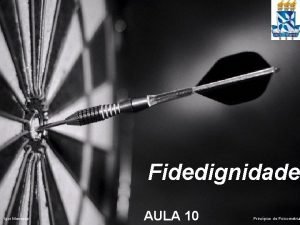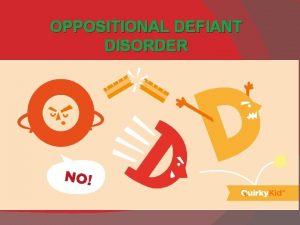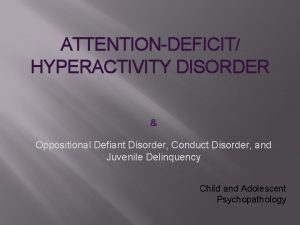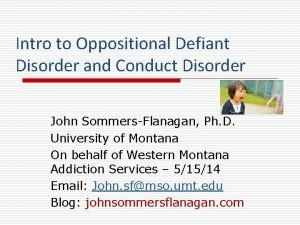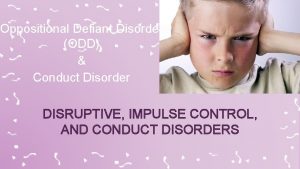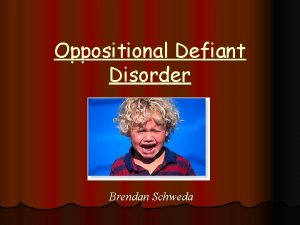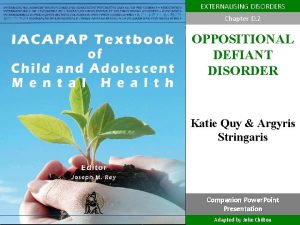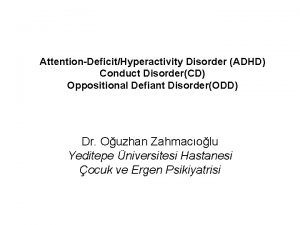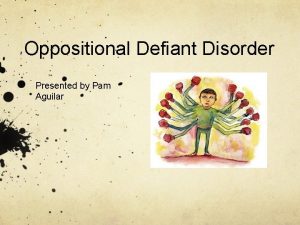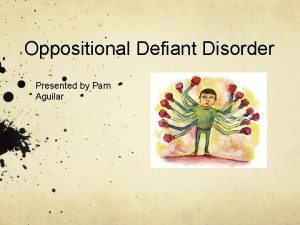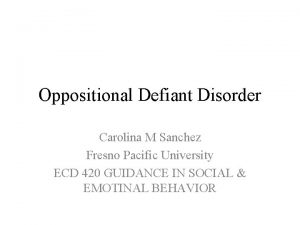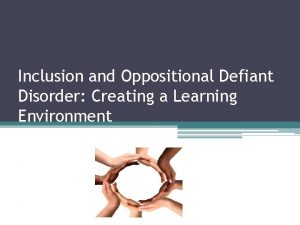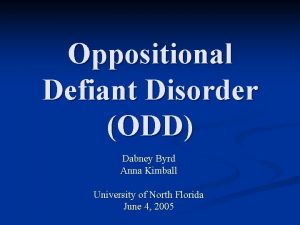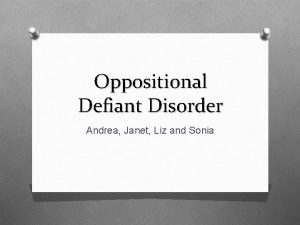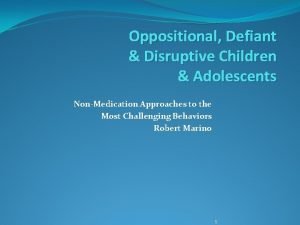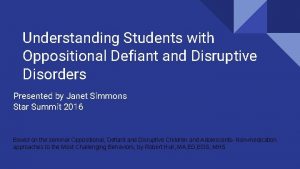Oppositional Defiant Disorder Hali Richardson Scott Hamer Katie




























- Slides: 28

Oppositional Defiant Disorder Hali Richardson Scott Hamer Katie Brinson

Canadian Teachers Top Three Concerns 1. Child and Youth Mental Health 2. Child and Youth Poverty 3. Safe and Caring Schools CBC News: http: //www. cbc. ca/news/canada/newfoundland-labrador/mental-illness-behavioural-issues-worry-teachers-schoolcounsellors-1. 2956530

Presentation Outline • O. D. D. Definition • DSM Criteria • Prevalence • Theories of O. D. D. • Evaluation & Diagnosis • Treatment • Classroom Management of O. D. D.

O. D. D. Definition “Physicians define O. D. D. as a pattern of disobedience, hostile, and defiant behavior directed toward authority figures. ” Reference: : ODD: A guide for families by American Academy of Child and Adolescent Psychiatry

DSM – IV Criteria The Diagnostic and Statistical Manual of Mental Disorders A pattern of negative, hostile, and defiant behavior lasting at least six months during which four or more of the following are present: - Often loses temper - Often argues with adults - Often actively defies or refuses to comply with adults’ requests or rules - Often deliberately annoys people - Often blames others for his or her mistakes or misbehavior - Is often touchy or easily annoyed by others - Is often angry and resentful - Is often spiteful and vindictive Reference: : American Psychiatric Association: http: //www. psychiatry. org/practice/dsm

DSM – V Criteria The Diagnostic and Statistical Manual of Mental Disorders Some refinements were made to the criteria: - The symptoms were categorized into three groups (angry/irritable mood, argumentative/defiant behavior, and vindictiveness. ) - Behaviors associated with the symptom will be closely monitored to make sure the frequency of the behavior is considered to be a disorder. - A severity rating has been added to reflect current research (mild, moderate, severe). Reference: : American Psychiatric Association: http: //www. psychiatry. org/practice/dsm


Oppositional Defiant Disorder Conduct Disorder Disobedient towards authority Severe opposition to authority Hostility shown through annoying people or verbal aggression Hostility shown through physical aggression Behaviours may or may not be seen at home, in school, or other settings Behaviour will be persistent in all settings Basic rights of others are not usually violated Basic rights of others and age appropriate rules are often violated Reference: : Oppositional Defiant Disorder by Benny Denise

Prevalence • O. D. D. will typically be seen in children below the ages 9 – 10. • 5 -15% of children and adolescents have O. D. D. • 4% of children and adolescents have C. D. • It is more common in boys than girls. • If severe O. D. D. is untreated, a development of C. D. could occur. • O. D. D. and A. D. H. D. are the most common coexisting conditions. Reference: : : American Psychiatric Association: http: //www. psychiatry. org/practice/dsm


Biological Factors Theories of O. D. D. • A parent with a history of attentiondeficit/hyperactivity disorder (ADHD), ODD, or CD • A brain-chemical imbalance • A parent with a mood disorder (such as depression or bipolar disorder) • Exposure to toxins • A parent who has a problem with drinking or substance abuse • A mother who smoked during pregnancy • Poor nutrition • Impairment in the part of the brain responsible for reasoning, judgment, and impulse control Reference: : 2009 The American Academy of Child and Adolescent Psychiatry

Theories continued… Psychological Factors • A poor relationship with one or more parent • A neglectful or absent parent • A difficulty or inability to form social relationships or process social cues Social Factors • Poverty • Chaotic environment • Abuse • Neglect • Lack of supervision • Uninvolved parents • Inconsistent discipline • Family instability (such as divorce or frequent moves) Reference: : 2009 The American Academy of Child and Adolescent Psychiatry

Scenario “I hate you, you’re such a b****, I am too going to wear my red dress! You promised me yesterday, and if I can’t wear it today, I’m not getting ready for school!” Molly had been arguing about the dress for the past forty-five minutes. It was 8: 05, mom was running late, and the dress was filthy. That overwhelming exhausted feeling enveloped mom and, once again, she caved. “Go ahead and wear it”, she screamed. Resource: http: //www. sbhihelp. org/html/Oppositional. Defiant. Disorder-Solutions. htm

Characteristics of Oppositional Defiant Children • They possess a strong need for control. • They typically deny responsibility for their misbehavior and have little insight into how they impact others. • The ODD child is socially exploitive and very quick to notice how others respond. He then uses these responses to his advantage in family or social environments, or both. • These children tolerate a great deal of negativity- in fact they seem to thrive on large amounts of conflict, anger and negativity from others.

Diagnosis of O. D. D. While there is no single test that can diagnose ODD, a mental health professional can determine whether a child or adolescent has the disorder by assessing the child’s symptoms and behaviours. Many parents first call their family doctor for an evaluation.

Doctor’s Evaluation • Medical history is gathered and a medical examination is preformed. • The doctor will look for physical and other mental health issues. • A referral to a psychiatrist or mental health professional may be made if the doctor cannot find a physical cause for the symptoms. • Information will be gathered from parents, teachers and daycare providers.

Diagnosis • The behavior is severe. • The conflicts are with peers or authority figures. • The behavior is a result of stressful situations within the home. • The child reacts negatively to all authority figures, or only his or her parents or guardians. It is the psychiatrist or mental health professional that usually diagnoses ODD.

Treatment • Parent-Management Training Programs and Family Therapy • Cognitive Problem-Solving Skills Training • Social-Skills Program and School-Based Programs • Medication

Reference: http: //teacupsclassroom. blogspot. ca/2012/05/oppositional-defiant-disorder. html

Belong Build Cooperative Relationships-> Peer Helpers Build Positive Social Skills-> Social Club/SIW Collaborate-> with student/other teachers

Power Establish clear and consistent classroom rules Positive Expectations Positive Reinforcement

Freedom Making choices Avoid power struggles Help students understand manage their emotions

Fun Hands on activities Brain Breaks Tap into the student’s interests

Scenarios

Scenarios #1 The class has been asked to come to the carpet for Morning Meeting Time. When everyone is seated quietly you proceed to give them an overview of what the morning will look like. As soon as you mention that students will be writing in their agendas, Angus yells out, “No!!! I don’t want to write today!” He then runs and hides under his desk. What do you do as a teacher?

Scenarios #2 The students are working quietly in your classroom when a student raises their hand tells you that another student, Michelle keeps bothering them by whispering in their ear. You ask Michelle to stop and she continues to bother the other student. What you do you as a teacher?

Strategies • • • Provide simple choices State pre-determined consequences Listen before reacting Give brief and direct instructions Discuss the problem privately with the student Walk away before it gets too “hot” Praise students when they respond positively Establish a rapport Avoid making comments Give them classroom responsibilities Calming area/Break cards

Resources “Behave like Clint Eastwood in Dirty Harry — stay cool, calm, and collected under the most challenging situation. ” cbc news: http: //www. cbc. ca/news/canada/newfoundland-labrador/mental-illness-behavioural-issuesworry-teachers-school-counsellors-1. 2956530 Samaritan Behavioral Health: Solutions to Oppositional Defiant http: //www. sbhihelp. org/html/Oppositional. Defiant. Disorder-Solutions. htm ODD: A Guide for Families by the American Academy of Child and Adolescent Psychiatry “Miss. Teacup’s” Blog http: //teacupsclassroom. blogspot. ca/2012/05/oppositional-defiant-disorder. html Strategies to Work with Students with Oppositional Defiant Disorder By: Wendy Woolsey-Terrazas and Janice A. Chavez American Psychiatric Association http: //www. psychiatry. org/practice/dsm
 Idea definition of emotional disturbance
Idea definition of emotional disturbance The oppositional gaze
The oppositional gaze Oppositional defiant disorder
Oppositional defiant disorder Oppositional defiant disorder in adults
Oppositional defiant disorder in adults Durum eki nedir
Durum eki nedir Dereflection technique
Dereflection technique Malingering disorder
Malingering disorder Fannie lou hamer delta sigma theta
Fannie lou hamer delta sigma theta Fannie mae hamer
Fannie mae hamer Wayne hamer
Wayne hamer Fannie lou hamer apush
Fannie lou hamer apush Hamer rodriguez
Hamer rodriguez Cómo murio el dr hamer?
Cómo murio el dr hamer? Hvala na pažnji
Hvala na pažnji Dr. ryke geerd hamer
Dr. ryke geerd hamer Rode hamer psychologische test
Rode hamer psychologische test Docteur hamer tableau
Docteur hamer tableau Vagotonia hamer
Vagotonia hamer Ideje za hamer
Ideje za hamer Audience theory media
Audience theory media Oppositional gaze bell hooks
Oppositional gaze bell hooks Jenny richardson
Jenny richardson Isopicne
Isopicne Terry richardson abuse
Terry richardson abuse Emma sugarman
Emma sugarman Contatto ohmico
Contatto ohmico Von koch
Von koch![Re liveri [2006] qca 152 Re liveri [2006] qca 152](data:image/svg+xml,%3Csvg%20xmlns=%22http://www.w3.org/2000/svg%22%20viewBox=%220%200%20200%20200%22%3E%3C/svg%3E) Re liveri [2006] qca 152
Re liveri [2006] qca 152 Coeficiente de fidedignidade
Coeficiente de fidedignidade

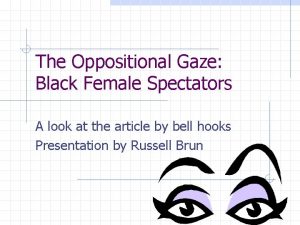
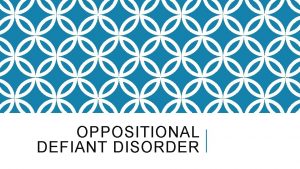
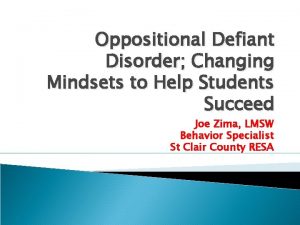




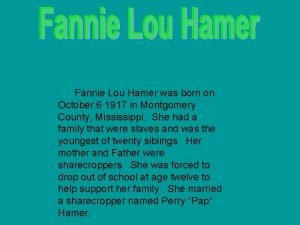





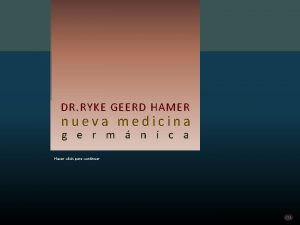


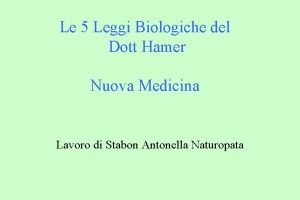



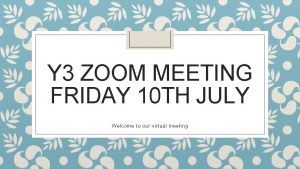
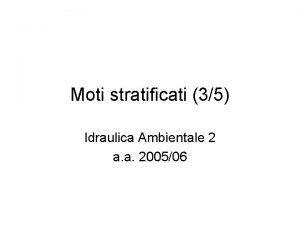


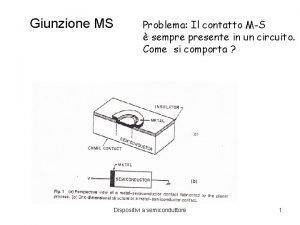
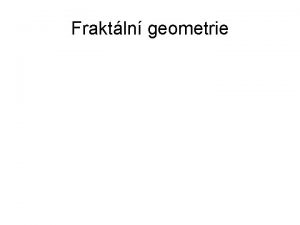
![Re liveri [2006] qca 152 Re liveri [2006] qca 152](https://slidetodoc.com/wp-content/uploads/2020/10/1024173_0ab07c7fa5fe15bbad1bb1a43f32eeb0-300x225.jpg)
